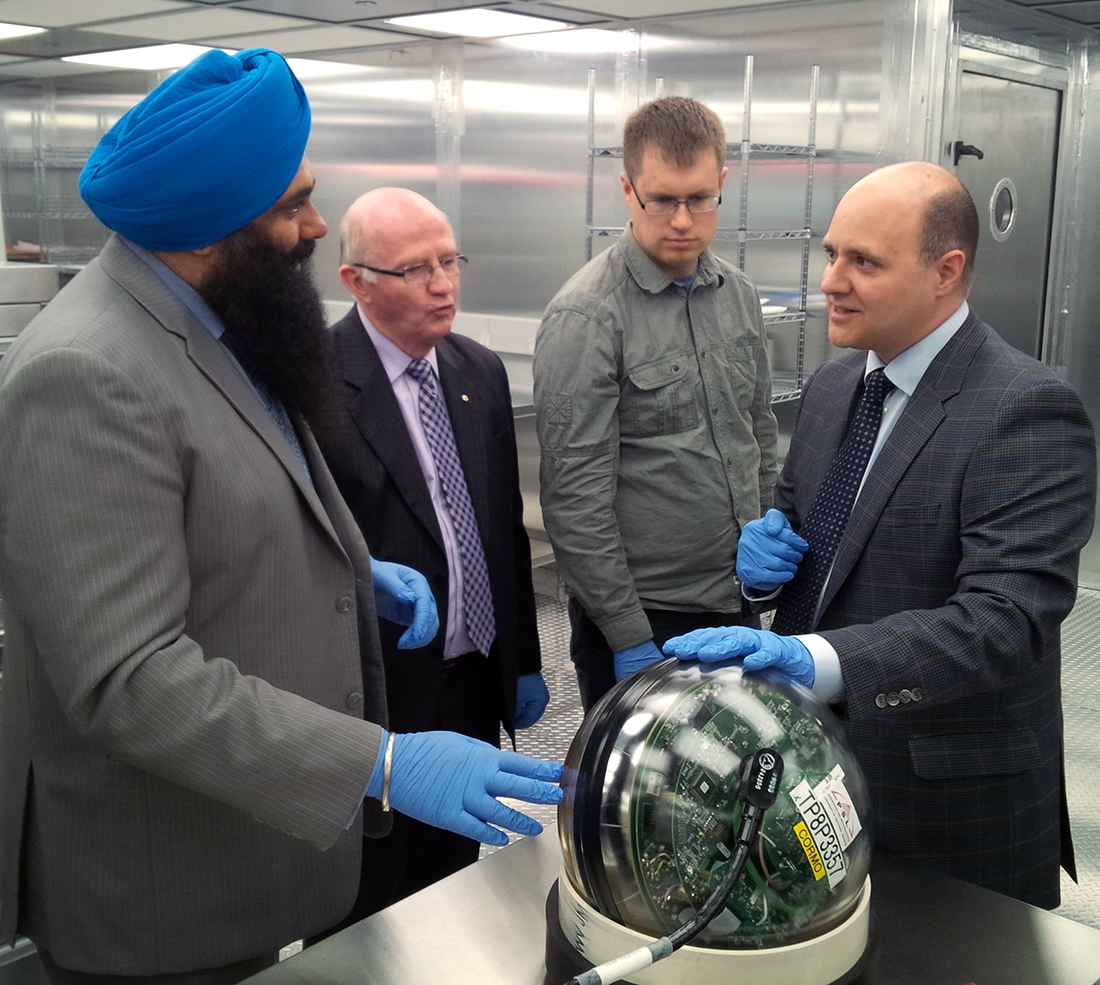
(L to R: The Honourable Tim Uppal, Lorne Babiuk, Zachary Friggstad, Darren Grant) Minister Uppal views one of the IceCube digital optical modules during a tour of Darren Grant's astroparticle physics laboratory in the Centennial Centre for Interdisciplinary Science. More than 5000 of these modules are deployed over a cubic-kilometre in the deep glacier at South Pole Station in Antarctica to study the properties of high energy neutrinos and search for dark matter.
Darren Grant, UAlberta's new Canada Research Chair in astroparticle physics, is looking into the darkest depths of space to decipher some of the universe's biggest mysteries.
A professor in the Department of Physics and the head of DeepCore, the low-energy extension of the IceCube Neutrino Observatory located in the Antarctic, Grant has dedicated his career to the detection and understanding two of nature's most elusive fundamental building blocks-neutrinos and dark matter.
"A neutrino is a subatomic particle, a foundational particle, from which the universe is made," explains Grant. "They're everywhere, billions of them passing through us every second-they go right through, and they don't interact. But we don't know very much about them, they are one of nature's great mysteries to study."
Grant's work has played a role in discovering what little there is to know about the neutrino. His PhD thesis on the Sudbury Neutrino Observatory demonstrated that neutrinos have mass, providing the first evidence for physics beyond the Standard Model of Particle Physics.
He says his CRC appointment is the next step in the design and construction of a new generation of neutrino detectors and helps further the U of A's position in this field. "I consider myself very fortunate to continue to receive the support and encouragement from these programs that make it possible to further pursue our understanding of the neutrino and dark matter."
The U of A is one of the four founding members of Canada's National Laboratory for Particle and Nuclear Physics, a full member of the SNOLAB Institute, and Canada's first IceCube collaboration institute.
Located at the South Pole, IceCube is the world's largest neutrino observatory and features a particle detector made of ice to detect the universe's highest-energy phenomena. IceCube is credited with discovering the first evidence of neutrinos from outside the solar system and was named the 2013 "Breakthrough of the Year" by Physics World magazine for the way it changes our understanding of our distant universe.
"The passion to better understand these particles-which continue to hold some of the Universe's best kept secrets-creates the drive to design cutting edge detector technologies to push this field to the limits of new discoveries," says Grant, who led Canada's contribution to the IceCube collaboration.
In developing these technologies, the researchers must venture to the most extreme environments on the planet, including South Pole station in Antarctica and the depths of the nickel mines in Sudbury at the IceCube and SNOLAB facilities, respectively.
"The University of Alberta offers an exceptional environment for research in astroparticle physics," he adds. "Our infrastructure for subatomic research at the U of A is second to none at Canadian universities, as are our technicians, technical resources, and funding."
Grant is one of the three new CRCs named to the Faculty of Science in April, along with Zachary Friggstad (computing science) and Todd Lowary (chemistry). Michael Lounsbury (Alberta School of Business) was the fourth new CRC for the U of A, and David Westaway's (Faculty of Medicine & Dentistry) existing chair was renewed.
The U of A's recently celebrated the $5.3M in funding for Canada Research Chairs with a visit from the Honourable Tim Uppal, Minister of State (Multiculturalism), who took the opportunity to tour Grant's particle-astrophysics laboratory for a first-hand demonstration of the highly sensitive specialized equipment.